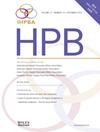肝门周围胆管癌神经浸润的肿瘤学影响:一项国际多中心研究。
IF 2.4
3区 医学
Q2 GASTROENTEROLOGY & HEPATOLOGY
引用次数: 0
摘要
背景:我们试图评估围肝门胆管癌(pCCA)患者行治疗目的切除的围神经浸润(PNI)的预后意义,并特别关注早期疾病。方法:从8个大容量国际肝胆中心收集了接受治疗目的切除的pCCA患者的数据。在整个队列和一部分早期pCCA患者中,分析了PNI状态、临床病理特征和长期生存之间的关系。结果:435例患者中,364例(83.7%)pni阳性。手术时,53例PNI患者行边缘再切除术;只有19例(35.8%)达到最终R0切缘,而34例(64.2%)在最终病理检查中有持续的R1切缘。PNI与整个队列中较差的总生存率(HR 1.52)以及T1/2 (HR 1.53)和淋巴结阴性(HR 1.60)患者的独立相关。虽然与淋巴结阴性患者的生存改善无关,但辅助化疗在淋巴结阴性疾病的PNI患者中提供了生存获益(50.8个月vs 28.6个月;P = 0.044)。结论:PNI是长期生存的独立预测因子,特别是在早期pCCA患者中。本文章由计算机程序翻译,如有差异,请以英文原文为准。
Oncologic impact of perineural invasion in perihilar cholangiocarcinoma: an international multicenter study
Background
We sought to evaluate the prognostic significance of perineural invasion (PNI) among patients undergoing curative-intent resection for perihilar cholangiocarcinoma (pCCA), with a specific focus on early-stage disease.
Methods
Data from patients who underwent curative-intent resection for pCCA were collected from eight high-volume international hepatobiliary centers. The association between PNI status, clinicopathological features, and long-term survival was analyzed in both the overall cohort and a subset of patients with early-stage pCCA.
Results
Among 435 patients, 364 (83.7 %) were PNI-positive. At the time of surgery, 53 patients with PNI underwent margin re-resection; only 19 (35.8 %) achieved a final R0 margin, whereas 34 (64.2 %) had a persistent R1 margin on the final pathological examination. PNI was independently associated with worse overall survival in the entire cohort (HR 1.52), as well as among patients with T1/2 (HR 1.53) and node-negative (HR 1.60) disease. Although not associated with improved survival among node-negative patients, adjuvant chemotherapy provided a survival benefit among patients with node-negative disease who had PNI (50.8 months vs. 28.6 months; p = 0.044).
Conclusion
PNI was an independent predictor of long-term survival, particularly among patients with early-stage pCCA.
求助全文
通过发布文献求助,成功后即可免费获取论文全文。
去求助
来源期刊

Hpb
GASTROENTEROLOGY & HEPATOLOGY-SURGERY
CiteScore
5.60
自引率
3.40%
发文量
244
审稿时长
57 days
期刊介绍:
HPB is an international forum for clinical, scientific and educational communication.
Twelve issues a year bring the reader leading articles, expert reviews, original articles, images, editorials, and reader correspondence encompassing all aspects of benign and malignant hepatobiliary disease and its management. HPB features relevant aspects of clinical and translational research and practice.
Specific areas of interest include HPB diseases encountered globally by clinical practitioners in this specialist field of gastrointestinal surgery. The journal addresses the challenges faced in the management of cancer involving the liver, biliary system and pancreas. While surgical oncology represents a large part of HPB practice, submission of manuscripts relating to liver and pancreas transplantation, the treatment of benign conditions such as acute and chronic pancreatitis, and those relating to hepatobiliary infection and inflammation are also welcomed. There will be a focus on developing a multidisciplinary approach to diagnosis and treatment with endoscopic and laparoscopic approaches, radiological interventions and surgical techniques being strongly represented. HPB welcomes submission of manuscripts in all these areas and in scientific focused research that has clear clinical relevance to HPB surgical practice.
HPB aims to help its readers - surgeons, physicians, radiologists and basic scientists - to develop their knowledge and practice. HPB will be of interest to specialists involved in the management of hepatobiliary and pancreatic disease however will also inform those working in related fields.
Abstracted and Indexed in:
MEDLINE®
EMBASE
PubMed
Science Citation Index Expanded
Academic Search (EBSCO)
HPB is owned by the International Hepato-Pancreato-Biliary Association (IHPBA) and is also the official Journal of the American Hepato-Pancreato-Biliary Association (AHPBA), the Asian-Pacific Hepato Pancreatic Biliary Association (A-PHPBA) and the European-African Hepato-Pancreatic Biliary Association (E-AHPBA).
 求助内容:
求助内容: 应助结果提醒方式:
应助结果提醒方式:


